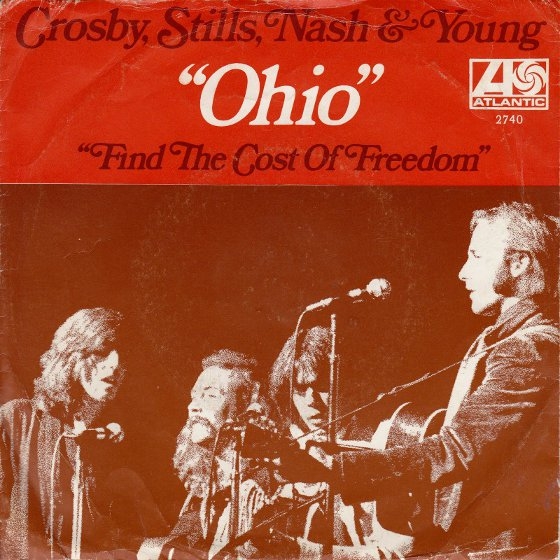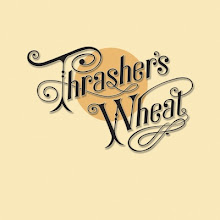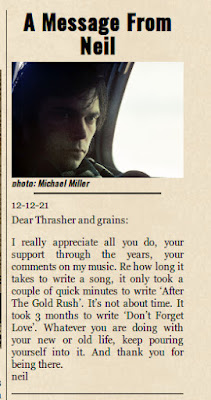50 Years Ago: “Four Dead In Ohio” | Decaturish

"Ohio" 45 Atlantic Records Single (w/ "Find The Cost of Freedom")
by Crosby, Stills, Nash & Young - May 1970
Last week, we posted our annual remembrance on 50 Years Later: "Ohio", Kent State & Tin Soldiers Still Marching .
The following excerpt from 50 Years Ago: “Four Dead In Ohio” | Decaturish by Jeff Cochran documents the various intersections of Neil Young and President Richard M. Nixon.
50 Years Ago: “Four Dead In Ohio” | Decaturish by Jeff Cochran
On The Human Highway . . . David Crosby handed Neil Young the May 15, 1970 issue of Life magazine. It featured photos of the tragedy at Kent State University. May 4, 1970. Four dead in Ohio. Enraged, despairing and caught up in the moment, Young quickly wrote “Ohio,” a deliberate and disquieting rocker evoking the anger and sadness felt when National Guardsmen turned their guns on protesting students: a representative group of the nation’s young people already embittered by America’s role in the Vietnam War.
Jimmy McDonough, in his Young biography, Shakey, summed it up by writing, “Neil Young, in ten lines, captured the fear, frustration and anger felt by the youth across the country and set it to a lumbering D-modal death march that hammered home the dread.”
And who had aroused the anger of America’s youth? President Richard M. Nixon.
And who did Neil Young call out in “Ohio?” President Richard M. Nixon.
Tin soldiers and Nixon coming.
We’re finally on our own.
This summer I hear the drumming,
Four dead in Ohio.
David Crosby once said that Young’s calling out Nixon’s name in the song “was the bravest thing I ever heard.” After all, Crosby noted, “it seemed like those who stood up to Nixon, like those at Kent State, were shot. Neil Young did not seem scared at all.”
“It’s still hard to believe I had to write this song,” Young wrote for the liner notes of his album, Decade, his three-disc compilation released in ’77. “It’s ironic that I capitalized on the deaths of these American students. Probably the most important lesson ever learned at an American place of learning.”
Recorded by Crosby, Stills, Nash and Young 11 days after the killings, “Ohio,” was released in June ’70, peaking at #14 on the Billboard Hot 100. The group was already riding high on the album charts with Deja Vu, released that March.
Two singles from the album, “Woodstock” and “Teach Your Children,” respectively, had already reached numbers 11 and 16. But overloading the market with CSNY product was of no concern at the time. Crosby told Rolling Stone the reaction by Stills and Nash was “How soon can we record it?”
According to Crosby, it was finished, along with the flip side (“Find The Cost of Freedom”), within 24 hours. Haste didn’t make waste. CSNY made a brilliant and captivating record. Dorian Lynsky of The Guardian called “Ohio” “arguably the perfect protest song: moving, memorable and perfectly timed.”


"Ohio" 45 Atlantic Records Single (w/ Bill of Rights picture sleeve)
by Crosby, Stills, Nash & Young - May 1970
Appalled by the loss of life and the toll it exacted, Neil Young created a powerful piece of music that is part and parcel of a tragic time in our nation’s history. How does one think of Kent State and not think of “Ohio?” The song may sound like a call to arms but it mainly serves as the most sobering of wake-up calls. “Ohio” accesses the pain humans inflict on one another in causes of political one-upmanship. “Don’t you know there’s a war going on?,” people used to ask during the Second World War. In 1970 it might have been asked, “Don’t you see what this war is doing to us?’
It was Young’s sense of humanity that informed “Southern Man” and “Alabama,” two songs he released as a solo artist in the early ’70s. Young focused on concerns of interest to his followers and peers. Inveighing against bigotry, lynching, and Governor George Wallace was expected from Neil Young. Naturally, he was on the side of our “better angels,” to paraphrase Lincoln.
Given the political and social tenets, either firmly or loosely held by people who bought his records and attended his concerts, Young was on solid ground with his beliefs: for example, his feelings for humanity at large. And when one holds firm to such core beliefs, defending or sympathizing with unpopular figures and political opponents are possible.
So who did Neil Young come to sympathize with? Richard M. Nixon.
Hello Mr. Soul . . . Cameron Crowe, writing in the February 9, 1979 issue of Rolling Stone reported on a memory from the summer of ’76. Neil Young is on tour. Young and his son, Zeke, are sitting on a hotel bed watching television. A news bulletin interrupts the broadcast. Pat Nixon, wife of the disgraced former president, had suffered a stroke. The report has an announcer talking over a film clip of a distraught Richard Nixon moving through the hospital’s revolving doors. Young took it all in and after some time passed, headed for his bus in the hotel’s parking lot. There he wrote a song, “Campaigner,” and played it in concert a few hours later.
Hospitals have made him cry
But there’s always a freeway in his eye
Though his beach got too crowded for a stroll.
Roads stretch out like healthy veins
And wild gift horse strain the reins
Where even Richard Nixon has got soul.
First called “Requiem for a President,” “Campaigner” was included on Decade.
“Guess I felt sorry for (Nixon) that night,” Young told Crowe.
The Losing End . . . Richard Nixon was always the campaigner, even when he said his campaign days were behind him. Two years after losing the Presidential election to John F. Kennedy, Nixon came up short again, defeated by Pat Brown in the 1962 California Governor’s race. On the morning after his defeat, he put the blame on the media during his self-proclaimed “last press conference.” Not about to leave the scene gracefully, he told the reporters, “You won’t have Nixon to kick around anymore. Just think how much you’re going to be missing.”
But there would be more Nixon press conferences. Hundreds of them. What else could he do but campaign for public office? Since 1946, he had been running for office. That year, fresh out of the Navy, he was elected to represent a Southern California congressional district. Four years later California voters sent him to the U.S. Senate. In ’52 he was elected Vice President; in his eight years of serving under President Eisenhower, he expanded the role of that office. Richard M. Nixon was on his way to the top.
The two tough, tight defeats in two years’ time would be enough for most politicos to seek other lines of work, but even as he was hurling invectives against the press in November ’62, Nixon, despite his promise that it would be his last press conference, already had plans for a comeback. Biographer Stephen E. Ambrose wrote that “Nixon couldn’t imagine living without campaigning, and didn’t try to.”
His reemergence was well-planned and successful. In ’64, he earned a truckload of favors by campaigning for Republican congressional candidates. Four years later, Nixon cashed in at the favor bank and was elected the 37th President of the United States.
Those who had followed Nixon’s political career from the start, having watched him sling mud in his first two campaigns, first against Jerry Voorhis and then against Helen Gahagan Douglas (wife of actor Melvyn Douglas), weren’t surprised that his own dirty work brought down his presidency. Nixon’s fall, not fast in coming but ruinous to his career and image, made him the lonely man walking San Clemente Beach in his dress shoes. Another comeback by the Campaigner seemed unlikely. After resigning the presidency, then relying heavily on a pardon from Gerald Ford, his health quickly declined. Not even three months out of the White House, phlebitis brought him near death’s door. And less than two years after that, Pat Nixon was in the hospital with a stroke. Yes, as with Neil Young, one could generate some sympathy for Richard Nixon.
All Day Presidents Look Out Windows . . . Mainly, there were two schools of thought regarding the way Nixon should be thought of, spoken of and written about in the first few years after he left the White House. Some felt he had suffered enough. That group was made largely of people who had supported him in office, and there were lots of them; Nixon won 49 states in his ’72 reelection bid. Then there were those against him and his policies from the start, as well as those who felt betrayed by his unconstitutional actions in office and the lying to cover it all up. That crowd didn’t want to see him pardoned, forgiven or granted the respect former presidents naturally receive. They had a point.
...
Some Things Never Change . . . Neil Young might have wondered about the state of Nixon’s mind on July 7, 1976. Walking through the hospital, worried about his wife, whom he truly loved; what was Nixon thinking? Where, if not for the foolishness of Watergate and other illegalities inspired by his paranoia, where would the Nixons be that day? The White House! On that day there were six and a half months remaining on the second term Nixon was elected to serve. For the Nixons, it could have been a happy time, when they planned for retirement, not a resignation. And perhaps Mrs. Nixon’s health wouldn’t be endangered. Richard Nixon, deep in his heart, could have accepted some blame for his wife’s condition. But, no, he would publicly attach blame to others. Less than a year later, in his interviews with David Frost, he took aim at The Final Days, Bob Woodward, and Carl Bernstein. He didn’t refer to the writers by their names, only as “trash.”
All I say is Mrs. Nixon read it, and her stroke came three days later. I didn’t want her to read it, because I knew the kind of trash they are. But nevertheless, this doesn’t indicate that they caused the stroke because the doctors don’t know what caused the stroke. But it sure didn’t help. Those who write history as fiction on third-hand knowledge, I have nothing but utter contempt. And I will never forgive them. Never. ………...
Less than a week after Nixon’s death, Neil Young completed his Sleeps With Angels album, another stellar effort from the hot streak he had going from ’88 through ’95. An observant track on the album is “Western Hero,” a soft but striking anthem to those who sacrifice for all, yet fade away, noticed by few. Young’s music and words are thoughtful, connecting with the images so well-captured on big screens and in our thoughts:
And on the shores of Normandy
He fought for you, he fought for me
Across the land and on the sea
But now he’s just a memory.
Just a memory, but one that inspires with deeds, when campaigning isn’t necessary.
Thanks Jeff for allowing a generous excerpt of your extensive article on Nixon, 70's politics and CSNY's "Ohio".
OK Star Wars fans on #StarWarsDay! Know your true history of May 4, 1970 at Kent State Univ., Ohio & Nat'l Guard shooting into a crowd of anti-war protesters https://t.co/ZKUgfJU6oZ … May The FOUR Be With You #MayThe4thBeWithYou @CSNofficial @thedavidcrosby @Neilyoung ☮️❤️ pic.twitter.com/QAFn1H6Y69
— ThrashersWheat (@ThrashersWheat) May 4, 2019
Labels: #KentStateMay4, #MayThe4thBeWithYou, Crosby Stills Nash Young, csny, kent state, neil young, ohio
































 Human Highway
Human Highway

















 Concert Review of the Moment
Concert Review of the Moment





 This Land is My Land
This Land is My Land

 FREEDOM In A New Year
FREEDOM In A New Year









 *Thanks Neil!*
*Thanks Neil!*




![[EFC Blue Ribbon - Free Speech Online]](http://www.thrasherswheat.org/gifs/free-speech.gif)











 The Unbearable Lightness of Being Neil Young
The Unbearable Lightness of Being Neil Young Pardon My Heart
Pardon My Heart



 "We're The Ones
"We're The Ones  Thanks for Supporting Thrasher's Wheat!
Thanks for Supporting Thrasher's Wheat!




 This blog
This blog 
 (... he didn't kill himself either...)
#AaronDidntKillHimself
(... he didn't kill himself either...)
#AaronDidntKillHimself









































































 Neil Young's Moon Songs
Neil Young's Moon Songs




 Civic Duty Is Not Terrorism
Civic Duty Is Not Terrorism Orwell (and Grandpa) Was Right
Orwell (and Grandpa) Was Right


 What's So Funny About
What's So Funny About 



1 Comments:
“Our society is run by insane people for insane objectives. I think we’re being run by maniacs for maniacal ends and I think I’m liable to be put away as insane for expressing that. That’s what’s insane about it.”
John Lennon
Peace 🙏
Post a Comment
<< Home